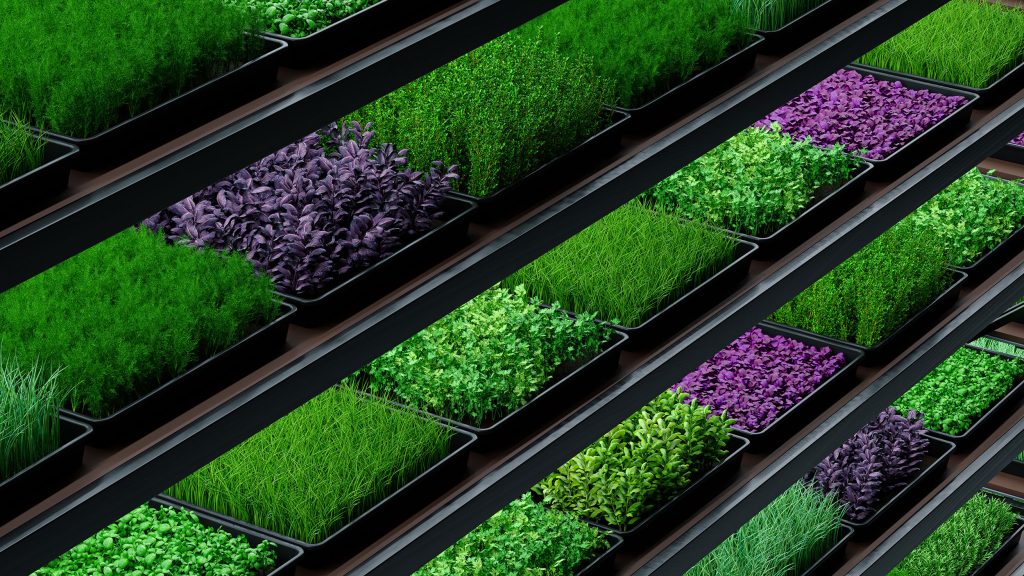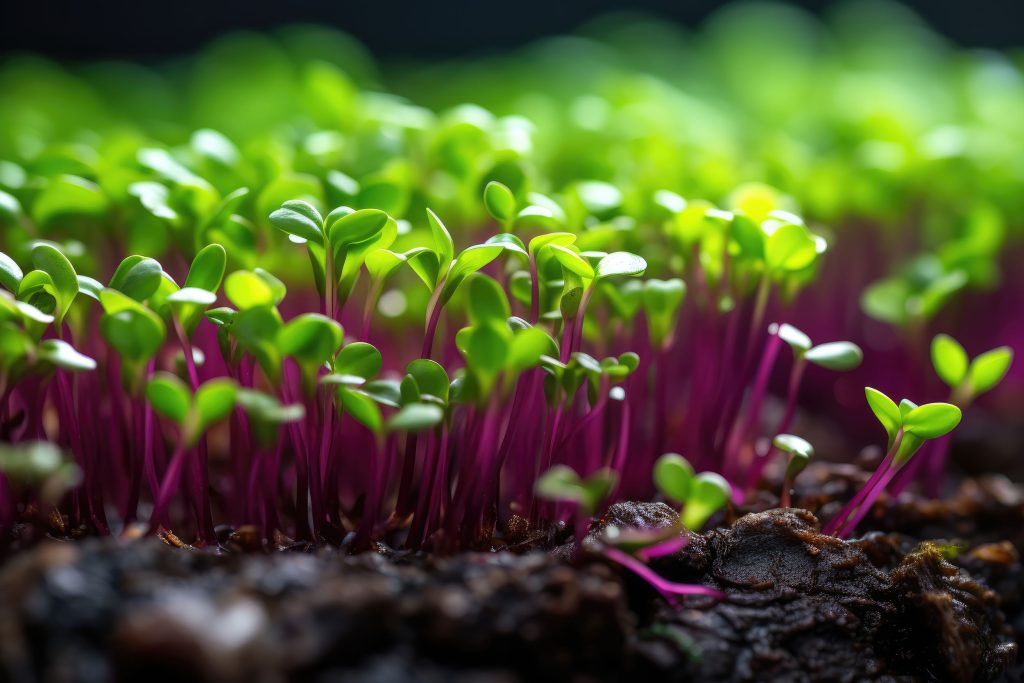
Introduction to Microgreens
Microgreens, the young seedlings of vegetables and herbs, are rapidly gaining fame in the culinary world, transforming everyday meals into extraordinary gourmet experiences. These diminutive greens are not just prized for their aesthetic appeal — their delicate textures and vibrant colors add a touch of elegance to any dish. But their allure goes beyond just visual appeal; these tiny plants pack a significant nutritional punch. With a nutrient profile far denser than their mature counterparts, microgreens have carved out a niche in both professional kitchens and home cooking.
Their rising popularity can be attributed to a growing awareness of health and wellness, coupled with a pursuit of culinary innovation. Chefs and home cooks alike are embracing microgreens for their versatility and the unique flavor profiles they bring to a wide array of dishes. From spicy radish and peppery arugula to earthy beet greens and sweet pea shoots, each variety offers a distinct taste and texture, making them a favorite for experimenting with new recipes and flavor combinations.
Moreover, microgreens are becoming a staple in household diets, not just for their gustatory delight but also for their impressive health benefits. Rich in vitamins, minerals, and antioxidants, these greens are a boon for those seeking to enhance their diet with nutrient-packed ingredients. They are more than just a garnish; they represent a shift towards mindful eating, where quality and nutritional value are as important as taste.
This article aims to explore the multifaceted world of microgreens, delving into their nutritional benefits and how they can be incorporated into everyday eating. We will look at what sets microgreens apart from other greens, their diverse types and flavors, and the science-backed health benefits they offer. Additionally, practical tips on how to include them in daily meals and even grow them at home will be provided, making it easy for anyone to add a touch of gourmet and a dash of health to their pl
What are Microgreens?
Microgreens, often referred to as vegetable confetti, are young vegetable greens, usually harvested just after the cotyledon leaves have fully developed, and sometimes after the first set of true leaves appear. This stage of plant growth is generally between 7 to 21 days after germination. At this point in their growth cycle, these greens are packed with intense natural flavors and nutrients, making them a highly sought-after ingredient in kitchens worldwide.
It’s important to differentiate microgreens from sprouts. Sprouts are germinated seeds that are consumed entirely – seed, root, stem, and undeveloped leaves, usually within 2 to 7 days of germination. In contrast, microgreens are harvested above the soil line and do not include the roots. This distinction is not just in form but also in their usage and nutritional content. While sprouts are known for their high water content and crisp texture, microgreens are celebrated for their stronger flavors and nutritional density.
Microgreens are not just young versions of greens; they are a category in themselves. Unlike mature vegetables that have reached their full size, microgreens offer a unique taste profile and are often more nutrient-dense. They are used in a variety of culinary applications for their intense flavors, ranging from sweet and mild to spicy and tangy. This makes them perfect for enhancing salads, sandwiches, and as garnishes on soups and main dishes, offering both a visual and taste appeal.
The diversity of microgreens available is impressive, encompassing a wide range of flavors and textures. For instance, radish microgreens offer a spicy, peppery kick, similar to mature radishes. Kale microgreens provide a mild, cabbage-like flavor, making them an excellent addition to salads and smoothies. Arugula microgreens bring a nutty, peppery taste, perfect for adding a zesty punch to dishes. Beet greens are known for their slightly sweet and earthy flavor, adding both color and taste to any culinary creation.
Each variety of microgreen not only brings its unique flavor to the table but also its own set of nutrients. This vast array of flavors and nutrients allows chefs and home cooks alike to experiment with these greens, enhancing the taste and nutritional value of their meals. The versatility and nutrient-rich profiles of microgreens make them an essential component of modern culinary practices, appealing to both the gourmet aficionado and the health-conscious eater.
Nutritional Profile of Microgreens

Microgreens are not just a culinary trend; they’re a nutritional powerhouse, offering a myriad of health benefits in a tiny package. These young seedlings of vegetables and herbs are loaded with vitamins, minerals, and other beneficial nutrients, often in greater concentrations than found in their mature plant counterparts.
Key vitamins found in microgreens include Vitamin C, known for its antioxidant properties and immune support; Vitamin E, crucial for skin health and cellular function; and Vitamin K, essential for blood clotting and bone health. The presence of these vitamins in high concentrations makes microgreens a highly efficient way to boost daily vitamin intake without the need for supplements.
In addition to vitamins, microgreens are a rich source of essential minerals. Potassium, vital for heart health and proper muscle and nerve function, is found in significant amounts. Iron, crucial for blood production and the transport of oxygen throughout the body, is also abundant in many microgreen varieties. Zinc, important for immune function and wound healing, is another mineral that these young greens supply in notable quantities.
The most striking aspect of microgreens is their nutrient density compared to mature vegetables. Research, including studies published in reputable journals such as the Journal of Agricultural and Food Chemistry, has revealed that microgreens can contain up to 40 times higher levels of vital nutrients than their fully-grown plant counterparts. This is particularly significant considering the modern diet, where nutrient-rich foods are often under-consumed.
This high nutrient density is a result of the plants being harvested in the early stages of growth when they are developing their first true leaves. During this phase, the plants are concentrating their energy and nutrients in a small, dense package, leading to a higher concentration of vitamins and minerals.
The exceptional nutrient profile of microgreens makes them an excellent dietary addition for those looking to enhance their nutritional intake. Whether for individuals aiming to improve their overall health, athletes seeking performance-enhancing nutrition, or families trying to provide a balanced diet, microgreens offer a simple, versatile, and potent solution. Their inclusion in daily meals can significantly contribute to meeting, and even exceeding, the recommended daily intake of many essential nutrients.
Health Benefits of Microgreens
The dense nutritional content of microgreens is more than just a dietary bonus; it translates into a multitude of tangible health benefits. These diminutive greens are a treasure trove of antioxidants, substances that play a crucial role in combating oxidative stress, a factor implicated in the aging process and numerous diseases. The antioxidants found in microgreens, including flavonoids and polyphenols, are known for their ability to neutralize harmful free radicals in the body, thereby reducing the risk of chronic diseases such as heart disease, diabetes, and certain types of cancer. This high antioxidant content not only defends against cellular damage but also contributes to overall health and longevity.
Microgreens also contribute significantly to digestive health. Their high fiber content is essential for maintaining a healthy digestive system. Fiber aids in digestion, prevents constipation, and helps maintain a healthy gut microbiome, which is crucial for effective digestion and overall health. Regular consumption of microgreens can therefore play an important role in digestive wellness, complementing a diet rich in fruits, vegetables, and whole grains.
Furthermore, the vitamins and minerals present in microgreens, such as vitamins C, E, and K, and minerals like zinc and iron, are vital for a robust immune system. These nutrients support various immune functions, from creating skin barriers against pathogens to producing antibodies and enhancing the body’s response to infections. Incorporating microgreens into one’s diet can thus be a natural strategy for enhancing immune resilience.
The health benefits of microgreens have been the subject of numerous scientific studies. Research published in esteemed journals, such as “The Journal of Agricultural and Food Chemistry,” has consistently highlighted the remarkable nutrient profile of these greens and their corresponding health advantages. These studies provide empirical support for the health claims associated with microgreens, making them more than just a culinary trend; they are a science-backed component of a healthy diet.
The regular inclusion of microgreens in a balanced diet can have far-reaching health implications. Given their high concentration of essential nutrients and antioxidants, microgreens offer a practical and effective way to boost overall health, mitigate the risk of chronic diseases, enhance digestive health, and strengthen the immune system. They are not just an ingredient for gourmet dishes; they are a small but mighty ally in the pursuit of health and wellness.
Incorporating Microgreens into Your Diet

Integrating microgreens into your diet is not just a step towards better health; it’s a journey into a world of enhanced flavors and textures that can revitalize your meals. These tiny greens are versatile and can easily be incorporated into a variety of dishes, adding both a nutritional boost and a gourmet touch.
One of the simplest ways to use microgreens is as a garnish. Their vibrant colors and unique shapes can elevate the presentation of soups, pizzas, and omelets. But their role is not just decorative; they add a burst of fresh flavor and a nutritional kick to these dishes. For instance, peppery arugula microgreens can add a zesty note to a creamy soup, while radish microgreens can provide a spicy contrast to a rich and cheesy pizza.
Salads and sandwiches are perhaps the most straightforward avenues for adding microgreens to your diet. You can mix different varieties of microgreens to create a salad that’s not only visually appealing but also packed with diverse flavors and nutrients. Pair them with a light vinaigrette, some nuts, and a sprinkle of cheese for a simple yet sophisticated salad. For sandwiches, microgreens can replace or complement traditional lettuce, adding a more nuanced flavor and a crunchier texture. A sandwich with avocado, tomato, and a hearty helping of microgreens, for example, is both a treat to the taste buds and a boost to your health.
.
Growing Your Own Microgreens

Growing microgreens at home is a convenient and sustainable way to enjoy these nutritious greens. They require minimal space, can be grown indoors, and are ready to harvest in just a few weeks. Basic supplies include seeds, a shallow container, and soil. The process involves sowing the seeds, providing adequate light and water, and harvesting the greens once they’ve grown. This not only ensures freshness but also adds a rewarding element to consuming these healthful plants.
Conclusion
Microgreens offer a unique combination of intense flavors, visual appeal, and nutritional density. Their ease of incorporation into various dishes makes them an excellent choice for anyone looking to enhance their diet. From their diverse range to their health benefits and ease of cultivation, microgreens are a small yet mighty component of modern healthy eating.
References
To substantiate the points discussed, the article will draw upon nutritional studies and expert interviews from sources like The Journal of Agricultural and Food Chemistry and other reputable publications in the field of nutrition and horticulture.
How useful was this post?
Click on a star to rate it!
Average rating / 5. Vote count:
No votes so far! Be the first to rate this post.
Author
-
Thom Thatsanaphon is a figure in the cannabis cultivation industry with a rich background spanning over 24 years. His journey began in the legacy market, where he honed his skills and knowledge in cannabis cultivation. Throughout his career in this field, Thom has demonstrated a deep understanding and passion for the art and science of growing cannabis. In recent years, Thom took on the role of Head of Cultivation at a facility based in Illinois. This position allowed him to apply his extensive experience and insights into managing large-scale cannabis cultivation operations. His leadership in this role has been marked by an emphasis on quality, innovation, and sustainable practices, which are crucial in the highly competitive and evolving cannabis industry. Currently, Thom is channeling his expertise into the pursuit of breeding top-tier genetics. This new phase of his career focuses on developing high-quality cannabis strains with superior traits such as potency, aroma, flavor, and medicinal properties. His work in breeding is not just about creating commercially viable strains, but also about pushing the boundaries of cannabis genetics to achieve new levels of excellence. Thom's dedication to the field is not only evident in his professional achievements but also in his commitment to staying abreast of the latest trends, technologies, and scientific advancements in cannabis cultivation and genetics. His deep understanding of the plant, combined with a forward-thinking approach, positions him as a significant influencer and innovator in the cannabis industry.
View all posts






